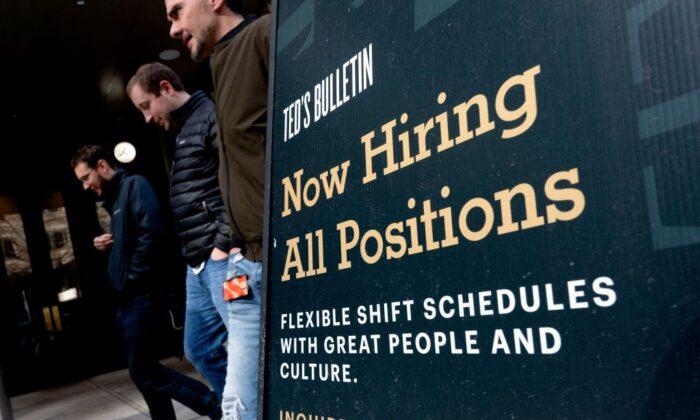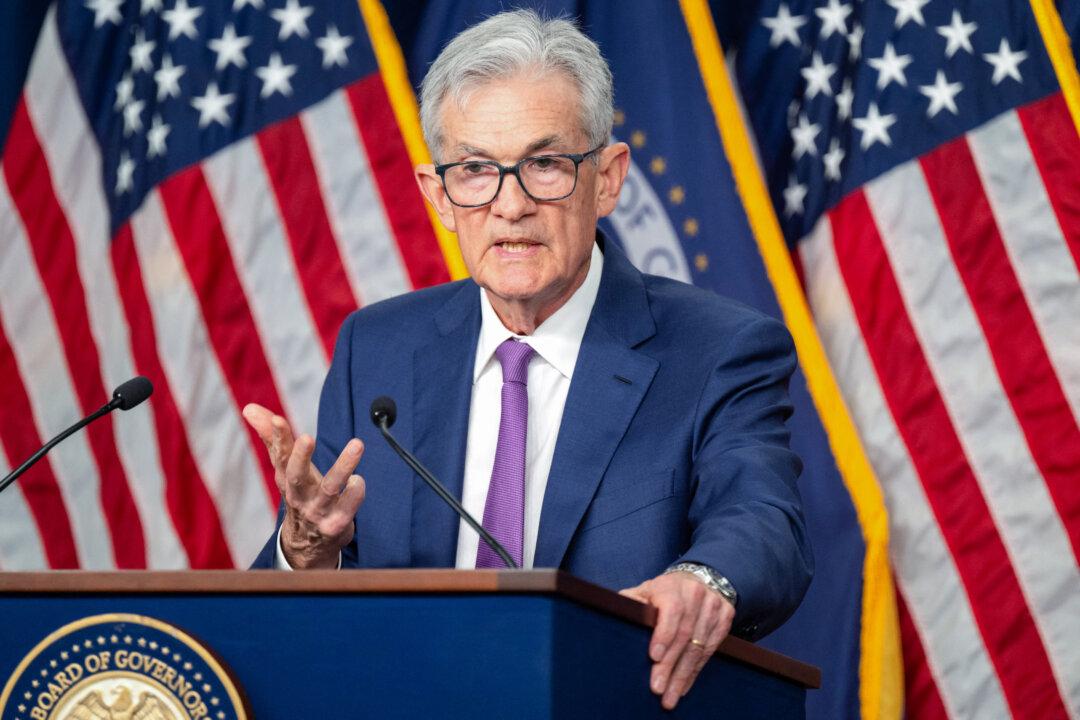Total nonfarm payroll employment, relased this morning, increased by 187, 000 jobs, and the unemployment rate dropped slightly, at 3.5 percent. Private sector jobs were 172,000, of which 15,000 were in government. However, private health and education, which tend to be supported substantially by government financing, was the largest of the separate sectors of employment, with 100,000 new jobs.
Analysis
Let’s look at our exclusive schedule of Jobs Creation by Average Weekly Wages:
As we stated previously, the greatest portion of jobs creation was in what are labeled above, as “Ed & health services,” which includes “Health care and social ass[istance].” Those tend to be heavily subsidized by government at the federal, state, and local level.
Other Data Points
The Institute for Supply Management’s Manufactuer’s Purchasing Managers Index (PMI) for July showed the industrial economy is contracting, but slower than last month, at 46.4 versus 46.0 in June. (A reading below 50 signals contraction.) On the other hand, the ISM Services Index showed the service economy expanding, but more slowly, also, at 52.7 versus 53.9 in June.The Job Openings and Labor Turnover Survey (JOLTS) for June, reported Aug. 1, was mostly stable, showing just 34 ,000 fewer job openings in June than in May and 288,000 fewer separations.
Building permits in June, released July 19, were at a seasonally adjusted annual rate of 1,440,000. This is 3.7 percent below the revised May rate of 1,496,000 and is 15.3 percent below the June 2022 rate of 1,701,000.
Privately owned housing starts in June were at a seasonally adjusted annual rate of 1,434,000. This is 8.0 percent below the revised May estimate of 1,559,000 and is 8.1 percent below the June 2022 rate of 1,561,000.
For June, personal income and outlays, released July 28, showed disposable personal income up 0.3 percent in current dollars and 0.2 percent in chained 2012 dollars. (“Chained dollars” is a measure of inflation that takes into account changes in consumer behavior in response to changes in prices.) Personal income in current dollars was up 0.3 percent.
The June Personal Consumption Expenditures (PCE) Index, excluding food and energy, released July 28, and reported to be the Federal Reserve’s preferred measure of inflation, printed at 4.1 percent, down one-half percent from May. PCE inflation, also called “headline inflation,” printed at 3.0 percent, down from April’s 3.8 percent in May.
Opinion and Outlook
The most troubling element of recent economic data was the downgrade of U.S. Treasury obligations from AAA to AA+ by credit ratings agency Fitch Ratings.“In Fitch’s view, there has been a steady deterioration in standards of governance over the last 20 years, including on fiscal and debt matters, notwithstanding the June bipartisan agreement to suspend the debt limit until January 2025. The repeated debt-limit political standoffs and last-minute resolutions have eroded confidence in fiscal management. In addition, the government lacks a medium-term fiscal framework, unlike most peers, and has a complex budgeting process...”Forgive me for finding the reportage to be more political than financial in nature as media outlets are now capitalizing on the Reuters, et. al. reportage on the indictment of former president Donald Trump indictment this week, implying cause and effect that is not found in the rating.
The Fitch downgrade, dated Aug. 1, has affected rates on government debt rather precipitously since, as can be seen in the rightmost portion of this chart:

Bill Ackman, the CEO of Pershing Square Capital, has reportedly said that he is shorting U.S. Treasurys, meaning he expects them to fall in value as rates increase. If Mr. Ackman’s prediction is fulfilled, and we think it will be, business will slow along with the economy. The higher rates will be required to be able to place American debt, notwithsnding what the Fed does.
We still anticipate a recession, but believe that it will be relatively mild and that will start in either the fourth quarter of this year or the first quarter of next year. We think that the expectation of recession has caused businesses to fortify their businesses’ hiring, debt levels, inventory, supply chains, and technology to reduce the effect of recession on the overall economy. Some businesses will, of course, suffer—and some may succumb—but the more resilient, better-managed businesses that have fortified their business and “right-sized” for the slowdown should be able to make do with few layoffs, even as their profits are squeezed and their stock price declines.
Other Factors Affecting the Economy
That said, household debt levels continue to concern us, particularly in a rising rate environment and given the uncertainty of the student debt situation. Student debt repayments are scheduled to resume in October after a long, three-year pause unless the Biden administration is able to succeed in working some jury-rigged scheme to reduce or absolve the debtors of their obligation. If the president cannot, a lot of consumer discretionary spending will be affected.Other Inflation Drivers
While headline inflation has cooled in recent readings, we’re not yet in the clear and consumers—the largest drivers of GDP—have certainly felt the pain. Cumulative inflation since President Joe Biden’s spending and energy policies took effect in January 2021, has caused the cost of the basket of goods used to measure inflation to increase 16 percent. In the current month, nearly every category of worker, save for the so-called “muscular professions” like mining, logging, construction, and utilities, lost purchasing power, even as nominal wages increased, when trimmed mean inflation (a schedule we present quarterly) is factored in.While June “headline” inflation has cooled to just 3 percent, core inflation (i.e., inflation less the effects of food and energy) remains elevated at a stubborn 4.8 percent, even above where it was two years ago, in June 2021, when it printed at 4.5 percent.
- The collapse of the Black Sea grain deal last month will likely affect grain prices as well as the cost of meat proteins since feed stock costs will increase. Prior to Russia’s invasion and the war commencing, Ukraine was the world’s fourth largest corn-exporting country and the fifth largest wheat-exporting country.
- Gasoline prices are escalating again, with the cost in California, e.g., now reportedly over $5 per gallon.
- The United States and many states are carrying too much debt. At the state level, much of the debt is “off balance sheet,” hidden behind sanguine estimates of pension fund returns. (We here in New York saw how overly optimistic pension calculations in some of our multi-employer union pension plans required a taxpayer bail-out engineered by Senate majority leader Chuck Schumer (D-N.Y.) as part of other legislation. Several states use similarly situated with their public employee pensions.)
- We again reiterate the need for the Fed to reduce its balance sheet as a principal driver of inflation and for Congress to address ongoing deficits and the dangerous, building, tsunami of costly entitlements we will ultimately not be able to pay.
- Partly because of these debt and deficits, as well as U.S. foreign policy, we’re seeing foreign central banks increasingly moving away from the U.S. dollar as their principal reserve currency. This “exorbitant privilege” of the dollar as the world’s primarily reserve currency has allowed us to sustain our profligate levels of spending and deficits since the Vietnam War era and supported the U.S. dollar’s value relative to other currencies. This higher value has, in turn, allowed Americans to buy imported goods more cheaply than they would have been had our dollar not been so valued. The well-being and standard of living of our children and grandchildren requires the U.S. government to be fiscally responsible.
- China’s economy has slowed substantially, which may affect U.S. supply lines and, thus, inflation.
GDP Prognostication
The advance estimate of gross domestic product for the second quarter of 2023 printed last week at 2.4 percent, well-exceeding the upper boundary of our—and other—expectation of 1.75 percent, which was in line with the consensus estimate of 1.8 percent. We await the two revisions that will come in coming months.For the current quarter, third quarter 2023, we think GDP will be at par with our estimate for second quarter 2023, but capped at the lower end of that prior estimate, so 1.25 percent. The full range would be between 0.75–1.25 percent. For fourth quarter 2023, we expect GDP growth to slow even more, to 0.0–0.5 percent. Again, that presumes that the Fed will hold firm to its 2 percent inflation target and not revise it upwards, explicitly or surreptitiously. (The Fed is subject to the political pressures of the incumbent president this close to an election year, despite protestations that the Fed is “nonpartisan.”)
_____________________________________________________





